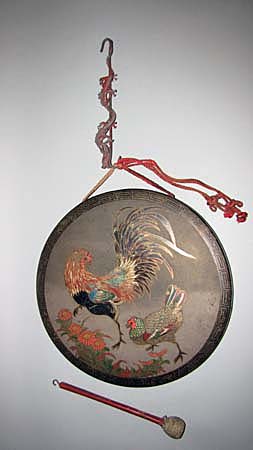
Owner: HWMC
Catalogue #: AS-IDST-37-14
Gongs
China ‘Luo’ (Daluo) – B
China
Chinese
Bronze, wood, silk, paint, leather
Early-Mid 20th century
Diameter: 14.75 in, Depth: 1.5 in
Idiophones – Struck Directly – Gongs
A Chinese suspended brass gong called a luo (generic term for gong) with rooster decoration, brass serpent holder and padded mallet. The Han Chinese luo is a popular percussion instrument made from ‘resonant bronze’ (xiangtong), an alloy of approximately 77 parts copper to 23 parts tin. It is hammered into a dish-shaped or basin-shaped structure, with the rim turned back. The luo is also found in a variety of sizes and this one is the daluo (‘large gong’) in comparison to the xiaoluo (‘small gong’). The daluo is a popular percussion instrument creating a stately and imposing atmosphere in Beijing opera. According to the Grinnel College Musical Instrument website, before gongs became common in China, the percussion ensemble was usually a zhonggu (“bells and drums”) ensemble. The earliest known gong dates back to the early Han dynasty (3rd century B.C.E). Further records show that musical instruments of the gong and cymbal types were introduced into China by at least 400 C.E., accompanying the importation of Buddhism from India as well as Central Asian influences by way of the Silk Road. Gongs, cymbals, clappers, and drums were featured prominently in the court orchestras and were depicted in many Buddhist mural paintings. They eventually became popular in folk music.
Resources: “Luo,” Alan R. Thrasher, “The Grove Dictionary of Musical Instruments,” 2nd ed., Laurence Libin, Editor in Chief; https://omeka-s.grinnell.edu/s/MusicalInstruments/item/2104
